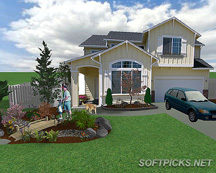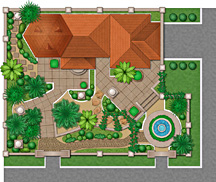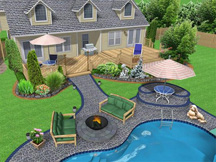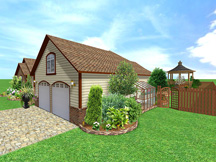Garden Design Software
Visualisation
If you struggle to visualise what your garden design will look like when it is finished, or if you don't even know where to start producing a design on paper, then you may benefit from one of the Garden Design programs available to run on your computer.
What design help you need and how much you are prepared to pay are decisions only you can make and therefore we can only offer an overview of what is on offer rather than recommend any specific programs.
Features
There are core features that you tend to find in most of these programs. It is how well they are implemented that distinguishes one program from another. You need to decide which are most important for your needs, for example:
Graphical Interface

Essentially you need to be able to produce a drawing on screen of what features you want in your garden and where they are to be placed in relation to each other and to fixtures that are already present such as your house, walls, fences and gates.
The more items available to you from the program's database, the easier it will be to accurately represent your design. It's also useful if you can specify the dimensions for items that you place in your garden including, for example, the height and spread of trees, dimensions of sheds, fences and gates, and the sizes for items of garden furniture.
The more comprehensive programs will incorporate some of the dimensions for you. For example, if you want a particular type of tree in your garden, some programs contain the typical dimensions of the tree as it grows to full maturity over a number of years.
Plant Database
Plants are an essential part of most gardens. They need to be chosen carefully for their type, purpose, colour, fragrance, size, flowering season and other characteristics.
A comprehensive database of plants that are well indexed makes it so much easier to select just the right plants to achieve the effects you want for your garden or for different areas of your garden.
3-D Modelling

With most garden programs, you develop the initial design as a two-dimensional drawing. However, many programs can then translate the flat drawing into a three dimensional model that produces a much enhanced experience of what your garden will be like.
Many programs allow you to navigate around and through the model, much as if you were walking through the real thing. Some can show what the garden will look like throughout the seasons and even how it will develop as the planting matures year after year.
Output Options
Seeing your design in animated three dimensions on screen is fine for deciding if you like a design but to turn it into reality, you need to be able to print it out.
Printing capability varies considerably from non-existent to comprehensive scaled drawings along with detailed shopping lists and possibly even suggested suppliers for some of the less common plants and materials.
You will also need detailed drawings if you plan to hire contractors to turn your design into reality and they may prefer drawings somewhat larger than you can produce from a typical desktop printer
Novelty Features

Some programs include facilities that you may not find in any of their competitors and you may decide on a particular program for this reason alone.
For example, you may want to see what your garden will look like against a particular background, such as the front or rear aspect of your house. Again, there may be features beyond the boundary of your garden that you want to include in the overall appearance or, on the other hand, effectively hide away.
For this purpose it can be useful if the program allows you to incorporate a photograph of the real landscape and then overlay your new generated garden design on top of the photograph.
Technical Requirements
Some features of these programs can be quite demanding on raw computing power, available storage and graphical capabilities of your equipment, so you may need to take into account what computer you have, its specification and operating system when choosing a program.
There are programs that you purchase and install on your own equipment and there are others that are services delivered over the Internet. In the case of the latter you need to consider the speed of your Internet connection or you could become very frustrated waiting for your design or 3-D model to be downloaded.
Learning Curve
If you haven't used your chosen program before, you will need time to become proficient at designing even at a basic level. Some programs are more difficult to use than others and so you may need to read through an instruction manual or follow instructional videos.
Unfortunately, there are few standards when it comes to using this type of program and therefore you may need to go through the learning curve more than once if you plan to try out a number of programs before deciding which you like best.
Program Availability

Some garden design software is free and, although you generally get what you pay for, the free versions may be all you need to help get your creative talents working. It makes sense, therefore to start with the free versions and work up from there until you are happy that you have all the features you need.
Just because a free program doesn't have all the features you want is not a reason to discount it out of hand. You may be able to assemble your ideal feature set by installing a number of free programs. After all, cost is not a factor when they are free.
Included in the free software category are programs that you sometimes find given away on magazines. Gardening magazines are obvious places to check, but you may also find them on computing magazines. Many of these programs are commercial products that have been superseded by later versions. A publisher will give away an earlier version in the hope that some readers will like it enough to buy the latest, often at a discount.
This is an ideal way to obtain a commercial program because you can effectively try before you buy and the free version may be all you need.
If you cannot achieve what you want with free software, then you need to explore paid-for products.
Given the financial costs and learning curves of some of these programs, most people will not want to be trying more than one or two at most. Consequently you would be wise to seek out other people's experiences before buying. That could be friends and neighbours or you could search around the Internet for reviews of any programs that interest you.
Read more about Design Concepts |
